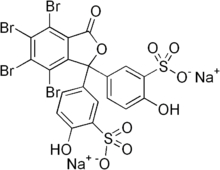
| |
| Names | |
|---|---|
| Preferred IUPAC name
Disodium 3,3′-(4,5,6,7-tetrabromo-3-oxo-2-benzofuran-1,1(3H)-diyl)bis(6-hydroxybenzene-1-sulfonate) | |
| Other names
Bromsulphthalein; Bromosulfophthalein; Bromosulphophthalein; BSP; Sulfobromophthalein
| |
| Identifiers | |
3D model (JSmol)
|
|
| ChEMBL | |
| ChemSpider | |
| ECHA InfoCard | 100.005.498 |
PubChem CID
|
|
| UNII | |
CompTox Dashboard (EPA)
|
|
| |
| |
| Properties | |
| C20H8Br4Na2O10S2 | |
| Molar mass | 837.99 g·mol−1 |
| Pharmacology | |
| V04CE02 (WHO) | |
Except where otherwise noted, data are given for materials in their standard state (at 25 °C [77 °F], 100 kPa).
| |
Bromsulfthalein (also known as bromsulphthalein, bromosulfophthalein, and BSP) is a phthalein dye used in liver function tests. Determining the rate of removal of the dye from the blood stream gives a measure of liver function.[1] The mechanism by which the liver detoxifies BSP is to attach it to glutathione which is the body’s master antioxidant.
- ^ Rosenthal, Sanford M. (1925). "Clinical Application of the Bromsulphalein Test for Hepatic Function". JAMA: The Journal of the American Medical Association. 84 (15): 1112. doi:10.1001/jama.1925.02660410020008.